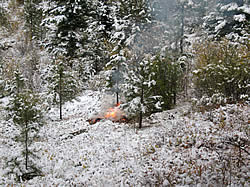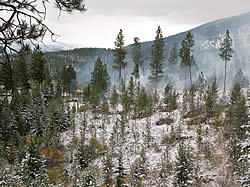
National Fire Plan Success Story
Rapid Response for Fuels Opportunities to the Ground: Lessons Learned
Bitterroot National Forest, Montana
National Fire Plan - Firefighting
2007


Lost Horse #1 project area(165 ac.) fuels completed (2008). Photos Courtesy of Cary A. Taylor, U.S. Forest Service.
In August of 2007, the Sula and Darby Districts, Bitterroot National Forest, Northern Region, submitted an aggressive proposal to commit $1.6 million dollars to 8,500 acres of high priority fuels work: 6,000 acres of slashing and thinning and 2,500 acres of piling. Funding was identified in September 2007, and hazardous fuels money became available. The Bitterroot National Forest had an incredible opportunity to make the project a reality and a very large challenge to expedite the acquisition process. Awarding a large contract within a short time frame requires coordination, organization, and a clear sense of purpose.
To meet this challenge the District Fuels Specialist and Zone Silviculturist coordinated with Western Acquisition Zone Contracting Officer and Forest Budget Officer to draft a Request for Proposal for a Service Contract, locate a Small Business entity capable of performing the large volume of work, and negotiate a fair price. By negotiating with the Small Business Administration and using an 8-(a) certified contractor, the timeline for solicitation and award where greatly reduced. This allowed the Forest $938,000 contract to treat 1,694 acres plus 4,700 ft of fire-line construction in less than 3 weeks.
Communities experiencing a higher resilience to wildfire include the Sula East Fork residents, the West Fork Residents, Lost Horse residents between Hamilton and Darby, and residents west of Stevensville.
After the award, thirteen Fire and Fuels staff learned Service Contract Inspecting skills. The more experienced Inspectors worked with the trainees to perform plot inspections of the slashing, piling and hand line construction work. Several Inspectors also received training in IAS payments and contractual correspondence. A greater appreciation for the work required to accomplish large-scale fuels treatments was apparent from all parties. The contract was successfully completed in July 2008
Lessons Learned
Positive:
- An experienced contracting officer is essential in providing advice to streamline and expedite the contract solicitation/award process.
- Use of 8-(a) certified contractors are not the answer to these types of situations.
- Accomplished high priority work not funded by stewardship contracts.
- Having projects with signed NEPA decisions and previously flagged unit boundaries expedited the ability to treat acres.
- Successful administration of 2007 contract gave us over a dozen new contractor proposals for the 2008 Bitterroot IDIQ (Indefinite Delivery/Indefinite Quantity) contract.
- Rotation of inspectors allowed the project to stay on track and provide developmental opportunities for personnel, including important national fire support.
- 3 fire people were trained in payments/acquisitions in Integrated Acquisition Systems (IAS).
- A better understanding of the workload that goes into fuels planning and implementation needs was acquired by everyone involved in the process.
Areas of Improvement:
- Language barriers of both government/contract inspectors/crews identify a need to improve language skills (Spanish-English and English-Spanish) for efficient project completion. Consider having a having a cheat-sheet developed to convey needs and work.
- Using 13 fire personnel allowed training opportunities; this is not efficient and consistent in reporting and inspecting standards. Always having a trainer present adds additional cost. Also, during times of high national fire support, use of fire and fuels funded personnel becomes challenging.
- The Forest does not have enough COR IIIs. Consider developing a forest or multi-forest pool across and coordinate project timing between disciplines.
- Explore cost efficient ways of training new inspectors while inspecting actual.
Contact: Lee McAlpine, 406-821-2324.